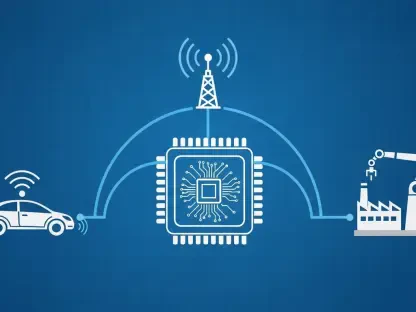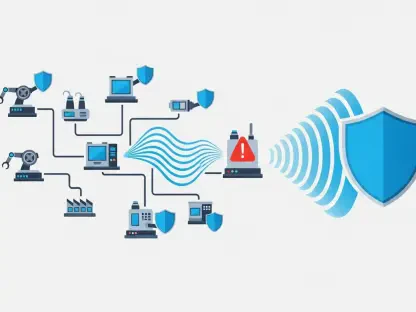In an era where healthcare relies heavily on digital innovation to deliver life-saving care, the backbone of this transformation—IT infrastructure—must rise to meet unprecedented demands, ensuring seamless integration of technology. Hospitals and clinics are no longer just places of healing; they’ve become complex digital ecosystems where electronic health records, real-time diagnostics, telemedicine, and even patient entertainment systems converge. Yet, many facilities still depend on outdated copper-based Local Area Networks (LANs) that struggle with speed, scalability, and reliability. Optical LAN, a cutting-edge solution powered by fiber-optic technology, emerges as a transformative alternative, promising to address these shortcomings with superior performance, enhanced security, and long-term cost savings. This shift isn’t merely a technical upgrade but a critical step toward ensuring that healthcare providers can keep pace with the digital age, delivering better outcomes for patients and staff alike in an increasingly connected world.
Challenges of Legacy Copper Networks
Healthcare facilities face mounting pressure as traditional copper-based LAN systems reveal their limitations in supporting modern medical operations. These aging networks, once reliable, are now constrained by inherent speed and distance barriers, unable to handle the massive data loads required for high-resolution imaging or real-time patient monitoring. Frequent upgrades, often needed every few years, come with hefty price tags and inevitable downtime—a dangerous disruption in environments where every second counts. Beyond performance issues, copper infrastructure demands substantial physical space for equipment and cabling, eating into areas that could be used for patient care. High energy consumption and ongoing maintenance further compound the problem, clashing with the industry’s goals of efficiency and sustainability. It’s evident that clinging to outdated systems risks not only operational inefficiencies but also the quality of care that patients depend on daily.
Another critical concern with copper-based LANs is their inability to adapt to the exponential growth of connected devices in healthcare settings. From medical staff accessing cloud-based records to patients streaming content, the sheer volume of traffic overwhelms legacy networks, leading to bottlenecks and potential failures. This infrastructure also struggles with security vulnerabilities, as copper is more susceptible to interference and unauthorized access, posing a significant threat to sensitive patient data. The sprawling nature of copper setups, with extensive cabling and multiple active components, complicates troubleshooting and increases points of failure. For an industry where reliability is non-negotiable, these shortcomings create a compelling case for exploring alternatives that can deliver robust, uninterrupted connectivity. The persistent strain on copper systems underscores a broader need for a network solution that aligns with the dynamic, data-driven reality of modern healthcare environments.
Rising Digital Demands in Medical Environments
The healthcare sector is undergoing a digital revolution, with technology permeating every aspect of patient care and facility management, placing immense demands on network infrastructure. Clinicians now depend on instantaneous access to electronic health records, diagnostic tools, and telemedicine platforms to make critical decisions, often under tight time constraints. Meanwhile, patients and visitors have come to expect seamless Wi-Fi for personal communication and entertainment, adding yet another layer of bandwidth strain. Administrators, on the other hand, rely on interconnected systems for smart building functions like access control, digital signage, and energy optimization. This convergence of diverse needs creates a perfect storm of connectivity challenges, where any lag or outage can disrupt everything from surgical planning to patient comfort, highlighting the urgency for a network capable of supporting this multifaceted digital landscape.
Beyond the immediate needs of staff and patients, the proliferation of Internet of Things (IoT) devices in healthcare amplifies the pressure on IT systems to perform without faltering. Smart medical equipment, wearable health monitors, and automated inventory systems generate continuous streams of data that must be processed and stored securely in real time. A single network failure could compromise critical operations, such as remote monitoring of a patient’s vital signs or the timely delivery of test results. Traditional networks, already stretched thin, simply cannot keep up with this escalating complexity. The stakes are higher than ever, as healthcare providers strive to integrate emerging technologies while maintaining the highest standards of care. A future-ready infrastructure must not only handle current demands but also anticipate the rapid evolution of digital tools that will shape the medical field in the years ahead, ensuring no aspect of service delivery is left behind.
Optical LAN as a Game-Changing Solution
Optical LAN, leveraging the power of fiber-optic technology, stands out as a revolutionary answer to the mounting challenges faced by healthcare IT systems. Capable of delivering speeds up to 100G with virtually limitless bandwidth, this solution ensures a network that can serve facilities for decades without the need for disruptive overhauls. Unlike copper-based setups, Optical LAN consolidates multiple services—ranging from telemedicine and cloud applications to secure guest Wi-Fi—onto a single converged network, slashing cabling requirements by up to 70%. This streamlined approach not only reduces operational complexity but also cuts costs significantly, offering a financially viable path for resource-constrained hospitals. With an extended reach of up to 20 kilometers, it minimizes the need for intermediate equipment, freeing up valuable space in medical facilities for direct patient care rather than housing bulky hardware.
The practical advantages of Optical LAN extend beyond raw performance to directly enhance the healthcare environment in meaningful ways. Its lightweight, thin fiber cables contribute to maintaining sterility by reducing dust accumulation and clutter in sensitive areas like operating rooms. Additionally, edge devices can be strategically positioned outside patient spaces, limiting in-room maintenance and preserving a quiet, restful atmosphere for recovery. Deployment and management are notably simplified, thanks to the technology’s efficient architecture, which allows IT teams to shift their focus from constant troubleshooting to driving innovation. By addressing both technical and operational needs, Optical LAN proves itself as a tailored fit for the unique demands of medical settings. This adaptability ensures that healthcare providers can maintain high standards of service while embracing the digital tools that are transforming how care is delivered across the board.
Sustainability and Security at the Core
Sustainability has become a pressing priority for healthcare organizations aiming to reduce environmental impact and achieve green building certifications, and Optical LAN aligns perfectly with these goals. This technology is up to eight times more energy-efficient than traditional copper systems, cutting power consumption by as much as 40% through fewer active electronics and reduced cooling requirements. Such efficiency translates into lower electricity costs and a smaller carbon footprint, supporting broader environmental, social, and governance (ESG) objectives. For facilities striving to balance operational demands with ecological responsibility, adopting a network solution that minimizes resource use without sacrificing performance is a strategic win. Optical LAN not only addresses immediate budgetary concerns but also positions healthcare providers as leaders in sustainable practices within their communities.
Security, equally vital in an industry handling highly sensitive patient information, is another area where Optical LAN excels over legacy alternatives. Built-in encryption, device authentication, and network segmentation provide robust safeguards against data breaches, while the technology’s immunity to electromagnetic interference and resistance to physical tapping enhance overall protection. Quality of Service (QoS) features allow for bandwidth prioritization, ensuring critical medical applications always take precedence, while centralized control reduces risks associated with local access points. In a sector governed by strict regulatory standards, these security measures are not just beneficial—they’re essential to maintaining trust and compliance. By embedding such strong defenses into the network foundation, Optical LAN offers peace of mind to healthcare providers, allowing them to focus on patient outcomes rather than potential cyber threats lurking in outdated systems.
Building a Future-Proof Healthcare Network
Optical LAN represents more than a technological upgrade; it stands as a strategic investment poised to redefine how healthcare facilities approach digital infrastructure. By slashing both capital and operational expenditures—reducing total cost of ownership by up to 50%—this solution delivers much-needed financial relief to organizations often operating on tight budgets. Its inherent scalability ensures seamless integration of emerging innovations, such as advanced IoT ecosystems or next-generation telemedicine platforms, without the burden of frequent, costly upgrades. Hospitals and clinics can confidently adopt cutting-edge tools knowing their network will support growth over the long haul. This forward-thinking design mitigates the risk of obsolescence, providing a stable foundation that evolves alongside the rapid advancements reshaping medical care in profound ways.
Looking back, the transition to Optical LAN marked a pivotal moment for many healthcare providers who recognized the limitations of clinging to outdated systems. The journey revealed that embracing fiber-optic technology was not just about solving immediate connectivity issues but about laying the groundwork for sustained excellence in patient care. As past implementations showed, the path forward involved careful planning to integrate this infrastructure, ensuring minimal disruption during rollout. The lessons learned underscored the importance of partnering with IT experts to tailor solutions to specific facility needs. Moving ahead, healthcare leaders were encouraged to prioritize long-term scalability and resilience in their network strategies, advocating for investments that aligned with both clinical and administrative goals. By taking these actionable steps, the industry positioned itself to navigate future digital challenges with confidence, ensuring that technology remained a steadfast ally in the mission to save lives.









